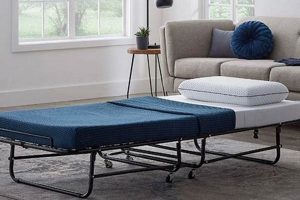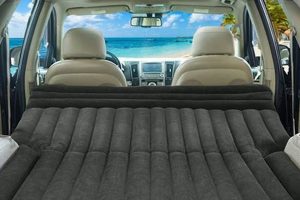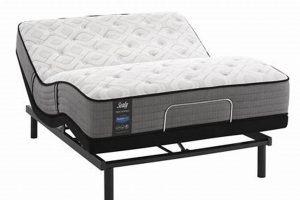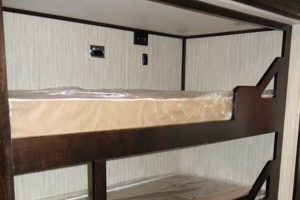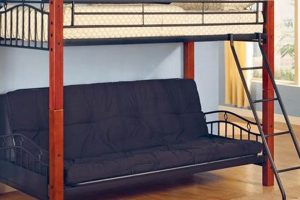A specialized sleeping surface designed for recreational vehicles equipped with fold-away beds is intended to maximize space without compromising comfort. These mattresses are typically thinner and lighter than standard residential models to accommodate the folding mechanism and space constraints of the RV environment. Examples include innerspring, memory foam, and hybrid constructions tailored to fit specific Murphy bed dimensions found in various RV models.
The significance of a well-chosen sleeping surface in this context lies in its ability to enhance the overall travel experience. A comfortable and supportive sleeping arrangement promotes better rest, contributing to improved driver alertness and passenger well-being. Historically, these mattresses were often an afterthought in RV design, but evolving consumer demands have led to a greater emphasis on quality and ergonomic considerations.
The subsequent sections will delve into factors to consider when selecting a sleeping solution for an RV Murphy bed, including material types, size compatibility, durability, and cost-effectiveness. Furthermore, options for customization and maintenance will be explored, providing a comprehensive guide for informed decision-making.
Considerations for RV Murphy Bed Mattress Selection
Selecting the appropriate sleeping surface for a recreational vehicle Murphy bed requires careful evaluation of several factors to ensure both comfort and practicality within the confined space.
Tip 1: Measure Accurately: Precision in measurement is paramount. The dimensions of the RV Murphy bed frame must be accurately recorded to ensure the chosen mattress provides a snug fit, preventing shifting and maximizing usable space when stowed.
Tip 2: Evaluate Mattress Thickness: Thickness significantly impacts the Murphy bed’s ability to fold and stow correctly. Consult the manufacturer’s specifications regarding maximum allowable mattress thickness to avoid damaging the mechanism or preventing complete closure.
Tip 3: Prioritize Lightweight Materials: Given the weight limitations often associated with RVs, opting for lightweight materials such as memory foam or hybrid constructions can minimize the overall burden on the vehicle and the bed’s folding mechanism.
Tip 4: Assess Firmness and Support: Consider individual sleep preferences and physical needs when selecting firmness. A mattress that provides adequate support can promote spinal alignment and reduce pressure points, contributing to a more restful sleep experience.
Tip 5: Examine Material Durability: RV mattresses are subject to unique stresses due to frequent folding and unfolding. Choose materials known for their resilience and resistance to wear and tear, such as high-density foam or reinforced innerspring systems.
Tip 6: Account for Climate: In environments subject to high heat or humidity, breathability is critical. Selecting mattresses with airflow-promoting designs can help regulate temperature and prevent moisture accumulation.
Effective evaluation of these considerations will result in the selection of a sleeping surface that provides both comfort and practicality within the limitations of an RV Murphy bed configuration.
The following section provides detailed product comparison and the practicalities of choosing between the myriad options available.
1. Dimensions
The dimensions of a sleeping surface designed for a recreational vehicle Murphy bed are of paramount importance due to the space-saving design inherent to these beds. Incompatibility in size renders the product functionally useless. Specifically, length, width, and thickness measurements must precisely match the RV Murphy bed frame’s internal dimensions and the manufacturer’s specifications. Failure to adhere to these dimensional constraints can result in an inability to close the bed properly, damage to the folding mechanism, or inefficient use of the limited space within the RV.
Consider a situation where the length or width exceeds the frame’s capacity. The folding process would be obstructed, placing undue stress on the hardware and potentially causing structural failure. A thickness beyond the allowed limit prevents full closure, leading to interference with other interior features or posing a safety hazard during transit. For example, an oversized mattress on a Class B RV Murphy bed could block access to storage compartments or interfere with seating arrangements. Many RV manufacturers, such as Winnebago and Airstream, provide precise dimension requirements for their specific Murphy bed models. Adhering to these specifications is critical.
In summary, the dimensional compatibility of a mattress with an RV Murphy bed directly dictates its functionality and overall value. Accurate measurement and adherence to manufacturer specifications are non-negotiable steps in the selection process. Neglecting these considerations can lead to mechanical issues, compromised space utilization, and potential safety risks. Therefore, precise dimensions are a core element when choosing a suitable sleeping surface for an RV Murphy bed, without which the functionality of the Murphy bed itself becomes critically impaired.
2. Thickness
The thickness of a mattress intended for use with an RV Murphy bed is a critical parameter that directly impacts the functionality and practicality of the entire system. It dictates not only comfort but also the ability of the bed to fold and stow properly, thus influencing space optimization within the recreational vehicle.
- Folding Mechanism Compatibility
The primary role of thickness is its direct correlation to the proper operation of the Murphy bed’s folding mechanism. An excessively thick mattress can prevent the bed from fully retracting into its stowed position, potentially damaging the hardware or obstructing access to other areas within the RV. For instance, if a manufacturer specifies a maximum thickness of 8 inches, exceeding that limit could render the bed unusable in its intended configuration.
- Space Optimization
Thickness significantly affects the amount of usable space when the Murphy bed is stowed. A thinner design allows for a more compact profile, freeing up valuable floor space within the RV. Conversely, an unnecessarily thick design compromises this benefit, negating the space-saving advantage of the Murphy bed concept. Examples include Class B RVs where every inch counts, and a thicker mattress reduces the available living area considerably.
- Weight Considerations
While not directly proportional, thickness often correlates with the overall weight of the mattress. Thicker models typically incorporate more material, adding to the overall load within the RV. Exceeding weight limits can negatively impact fuel efficiency and vehicle handling. A lighter, thinner option can contribute to better gas mileage
and a smoother driving experience, particularly in smaller RV models. - Comfort Trade-offs
There is often a trade-off between thickness and comfort. While a thicker mattress may initially seem more comfortable, excessively thick options can be impractical for RV Murphy beds. Manufacturers often employ advanced materials and construction techniques to maximize comfort within a thinner profile. Examples of this include using high-density memory foam or layered construction to provide adequate support and pressure relief despite reduced thickness.
In summary, the thickness of a mattress used in conjunction with an RV Murphy bed is a multifaceted consideration that extends beyond mere comfort. It directly influences the functionality of the bed, the optimization of space within the RV, and even the overall weight of the vehicle. Selecting the appropriate thickness involves balancing comfort preferences with practical limitations to ensure the Murphy bed system operates as intended and contributes positively to the RV travel experience.
3. Weight
The weight of a mattress designed for a recreational vehicle Murphy bed is a critical consideration that directly affects multiple aspects of the RV’s performance and usability. It is not simply a matter of convenience but a significant factor impacting fuel efficiency, vehicle handling, and the longevity of the Murphy bed mechanism itself.
- Fuel Efficiency and Vehicle Load Capacity
The cumulative weight of all items within an RV, including the mattress, directly influences fuel consumption. A heavier mattress adds to the overall load, requiring more energy to propel the vehicle. This increased fuel consumption translates to higher operating costs over the lifespan of the RV. Furthermore, RVs have specific weight limits, and exceeding these limits can compromise safety and potentially damage the vehicle’s suspension and frame. A lighter mattress contributes to staying within these critical weight restrictions.
- Murphy Bed Mechanism Strain
The folding and unfolding of a Murphy bed places stress on its mechanical components, including hinges, springs, and support structures. An excessively heavy mattress intensifies this stress, potentially leading to premature wear and tear, decreased reliability, and eventual failure of the mechanism. Regular maintenance and replacement of these components can be costly and inconvenient. A lighter option reduces the strain, extending the lifespan of the Murphy bed system and minimizing maintenance requirements.
- Ease of Handling and Installation
A lighter mattress simplifies installation and removal, making it easier to clean, rotate, or replace the bedding. This is particularly relevant in the confined spaces of an RV, where maneuvering bulky objects can be challenging. A heavier mattress requires more physical effort and may necessitate assistance, increasing the risk of injury or damage to the surrounding interior. Lighter models promote greater convenience and reduce the potential for complications during maintenance procedures.
- Material Composition and Construction
The weight of a mattress is directly tied to its material composition and construction. Traditional innerspring mattresses tend to be heavier than memory foam or hybrid options. Selecting materials known for their lightweight properties, such as high-density foam or strategically designed innerspring systems, can significantly reduce the overall weight without sacrificing comfort or support. Manufacturers are increasingly focused on developing lighter alternatives that meet the specific demands of the RV market.
In conclusion, the weight of a mattress for a recreational vehicle Murphy bed is an essential factor with far-reaching implications. It impacts fuel efficiency, the longevity of the Murphy bed mechanism, ease of handling, and material selection. A careful assessment of weight, alongside other critical parameters, ensures that the mattress contributes positively to the RV experience rather than becoming a source of burden or complication.
4. Material
The selection of material in a recreational vehicle Murphy bed mattress is paramount, directly influencing comfort, durability, weight, and the overall suitability for use within the confined and often dynamic environment of an RV. The material dictates the mattress’s ability to withstand frequent folding, temperature fluctuations, and the potential for moisture exposure.
- Foam Density and Composition
Foam density, whether memory foam, latex, or polyurethane, dictates support, longevity, and breathability. High-density foam provides superior support and resists compression over time, essential for maintaining comfort during extended travel. Open-cell foam structures enhance airflow, mitigating heat retention and moisture build-up. For example, a high-density memory foam mattress conforms to the body, alleviating pressure points, while a latex mattress offers a responsive feel and natural breathability. The choice depends on individual comfort preferences and environmental considerations, such as humidity levels.
- Innerspring Coil Type and Gauge
For innerspring mattresses, the type of coil system (e.g., Bonnell, pocketed) and the gauge (thickness) of the steel dictate support and motion isolation. Pocketed coils, where each spring is individually wrapped, minimize motion transfer, crucial in shared sleeping spaces within an RV. A lower gauge indicates thicker, more durable coils, providing firmer support and greater resistance to sagging. For instance, a mattress with a high coil count and a lower gauge offers enhanced support and reduces disturbance from a partner’s movements. This is particularly useful given the often-smaller sleeping quarters of an RV.
- Fabric Cover Properties
The fabric cover impacts breathability, moisture resistance, and overall durability. Materials such as cotton, bamboo, or specialized performance fabrics enhance airflow and wick away moisture, promoting a cooler and drier sleep environment. Reinforced stitching and durable weaves increase resistance to wear and tear, essential given the frequent folding and unfolding of a Murphy bed. For example, a bamboo-derived fabric offers natural breathability and antimicrobial properties, while a polyester blend provides enhanced durability and stain resistance. The selection should balance comfort, hygiene, and longevity.
- Flame Retardant Compliance
Federal regulations mandate flame retardant compliance in mattresses. Materials used to meet these standards can vary, impacting overall comfort and potential off-gassing. Options include inherently flame-resistant fibers, such as wool, or chemically treated materials. Certifications like CertiPUR-US ensure that foams meet specific standards for low VOC emissions, promoting better indoor air quality within the confined space of an RV. Selecting mattresses with transparent information regarding flame retardant compliance and certifications minimizes potential health risks and ensures regulatory adherence.
The interplay of these material facets dictates the overall performance and suitability of a sleeping surface intended for an RV Murphy bed. Careful consideration of foam density, coil type (if applicable), fabric cover properties, and flame retardant complianc
e ensures a balance of comfort, durability, and safety, optimizing the sleep experience within the unique constraints of the recreational vehicle environment.
5. Support
Adequate support within a recreational vehicle Murphy bed mattress is essential for maintaining spinal alignment and minimizing pressure points, directly impacting sleep quality. The constrained space of an RV necessitates that this support be achieved without excessive thickness or weight. Insufficient support can lead to discomfort, back pain, and disrupted sleep, negating the benefits of travel. The correlation between support and the RV sleeping surface is one of direct cause and effect. An unsupportive mattress results in poor sleep, whereas a supportive one fosters rest and recovery.
Examples of support mechanisms in these mattresses include high-density foam cores, strategically placed innerspring coils, and layered construction techniques. High-density foam provides a stable and even surface, while pocketed coil systems offer targeted support to specific areas of the body. Layered designs often incorporate different foam types to balance support and comfort. For instance, a mattress might combine a high-density base layer for support with a memory foam top layer for pressure relief. The practical significance lies in the enhanced sleep experience, which translates to improved alertness, reduced fatigue, and a more enjoyable travel experience for RV occupants.
The challenge in achieving optimal support lies in the need to balance it with other factors, such as weight, thickness, and durability. Manufacturers must engineer mattresses that provide adequate support without exceeding weight limits or compromising the folding mechanism of the Murphy bed. In summary, support is not merely a desirable feature but a core requirement for a functional and comfortable recreational vehicle Murphy bed mattress. Its absence negatively impacts sleep quality and overall well-being, highlighting the critical importance of careful consideration when selecting a sleeping solution for this specific environment.
6. Durability
Durability, in the context of recreational vehicle Murphy bed mattresses, constitutes a critical performance attribute directly influencing longevity, cost-effectiveness, and user satisfaction. Given the unique stresses imposed by the RV environment and the folding mechanism of the Murphy bed, the capacity of the mattress to withstand wear and tear is paramount.
- Material Resistance to Compression and Deformation
The ability of the core materials, such as foam or innerspring coils, to resist compression and deformation under repeated use is a primary determinant of durability. High-density foams and tempered steel coils maintain their structural integrity over time, preventing sagging and ensuring consistent support. For instance, a high-density memory foam mattress will retain its shape and support properties longer than a low-density alternative, even after extensive folding and unfolding. The implications of poor compression resistance include diminished comfort, compromised spinal alignment, and a significantly shortened lifespan, necessitating premature replacement.
- Fabric Integrity Under Stress
The outer fabric covering the mattress is subject to considerable stress during folding and unfolding, as well as from abrasion against the Murphy bed frame. Durable fabrics, such as reinforced polyester blends or tightly woven cotton, resist tearing, stretching, and seam failure. A high-quality fabric cover also provides protection against moisture and staining, further enhancing the mattress’s longevity. Conversely, a flimsy or loosely woven fabric is prone to damage, compromising the mattress’s structural integrity and aesthetic appeal. The selection of a robust fabric is therefore essential to withstand the rigors of RV travel and Murphy bed operation.
- Resistance to Environmental Factors
Recreational vehicles are often exposed to a range of environmental factors, including temperature fluctuations, humidity, and sunlight. The mattress must be capable of withstanding these conditions without degrading or losing its performance characteristics. Materials resistant to moisture absorption, UV degradation, and temperature-induced changes in firmness are critical for maintaining durability. For example, closed-cell foams and UV-resistant fabrics can prevent mold growth and fading, even in humid or sunny environments. Failure to account for these factors can lead to premature deterioration and a compromised sleeping experience.
- Seam and Stitching Strength
The seams and stitching that hold the mattress components together represent potential points of failure if not properly reinforced. High-quality stitching techniques, such as double stitching or reinforced seams, enhance the mattress’s structural integrity and prevent separation under stress. Durable thread and meticulous craftsmanship are essential to withstand the forces exerted during folding and unfolding. Weak or poorly executed seams are prone to unraveling, leading to bulging, sagging, and ultimately, a compromised mattress structure. The robustness of the seams and stitching is therefore a key indicator of overall durability and longevity.
These facets collectively emphasize the importance of durability in the context of recreational vehicle Murphy bed mattresses. The selection of materials and construction techniques that enhance resistance to compression, stress, environmental factors, and seam failure is essential for ensuring a long-lasting, comfortable, and cost-effective sleeping solution for RV travel. The emphasis on durability as a central purchasing criterion directly translates to increased value and satisfaction for the RV owner.
Frequently Asked Questions
This section addresses common inquiries and misconceptions regarding sleeping surfaces designed for recreational vehicle Murphy beds, providing concise and factual information.
Question 1: Are RV Murphy bed mattresses the same as standard residential mattresses?
RV Murphy bed mattresses are specifically engineered with considerations for weight, thickness, and durability to accommodate the space constraints and folding mechanisms inherent to recreational vehicles. While some residential mattresses may fit, they often lack the necessary characteristics for optimal performance and longevity within an RV environment.
Question 2: What is the typical thickness of an RV Murphy bed mattress?
The typical thickness varies depending on the Murphy bed design and manufacturer specifications. However, RV Murphy bed mattresses generally range from 5 to 11 inches in thickness. Exceeding the recommended thickness can prevent the bed from properly folding and stowing.
Question 3: What type of mattress is best suited for an RV Murphy bed?
The optimal mattress type depends on individual preferences and needs. However, lightweight options such as memory foam, latex, or hybrid mattresses are often favored due to their comfort, support, and ease of folding. Innerspring mattresses, while durable, tend to be heavier and may not be suitable for all RV Murphy bed systems.
Question 4: How can I ensure that the RV Murphy bed mattress is the correct size?
Accurate measurement of the Murphy bed fr
ame is essential. Consult the RV manufacturer’s specifications or measure the interior dimensions of the bed frame to determine the precise length, width, and thickness requirements. Discrepancies in size can lead to improper fit and functional issues.
Question 5: How should an RV Murphy bed mattress be maintained?
Regular rotation of the mattress can promote even wear and prolong its lifespan. Utilize a mattress protector to guard against spills and stains. Periodically vacuum the mattress surface to remove dust and debris. Avoid placing heavy objects on the mattress when it is in the stowed position to prevent deformation.
Question 6: Do RV Murphy bed mattresses require special flame retardant treatments?
RV mattresses are subject to the same federal flammability standards as residential mattresses. Manufacturers employ various methods to meet these requirements, including the use of inherently flame-resistant materials or chemical treatments. Certifications such as CertiPUR-US indicate that the mattress has been tested for harmful chemicals and VOC emissions.
Key considerations in the selection of an RV Murphy bed mattress include size compatibility, weight, thickness, material composition, and maintenance requirements. Attention to these factors ensures a comfortable and functional sleeping solution within the constraints of the RV environment.
The subsequent section will explore methods for customizing a sleeping surface for an RV Murphy bed.
Conclusion
The preceding exploration of the specialized sleeping surface designed for recreational vehicle Murphy beds has highlighted the nuanced factors involved in its selection and utilization. Key considerations encompass precise dimensional compatibility, weight limitations, material composition influencing both comfort and durability, and the essential role of adequate support within the confined space. Furthermore, the frequently asked questions addressed prevalent misconceptions and provided actionable guidance on maintenance and safety compliance.
The effective integration of a suitable RV Murphy bed mattress into a recreational vehicle configuration directly impacts the overall travel experience. Diligent assessment of individual needs and adherence to manufacturer specifications are paramount in ensuring a functional, comfortable, and enduring sleeping solution. Continued advancements in material science and design innovation promise to further refine the performance and lifespan of these essential components, thereby enhancing the utility and appeal of recreational vehicle travel.


